THDP DESIGNS AND RENEWS 12 LUXURY APARTMENTS WITH A ‘MICROLOCAL’ LANGUAGE
It is undeniable that Venice is a source of endless inspiration. A city built upon water, with extraordinary palaces that loom over winding canals seems like a fragment of one’s imagination. Venice is a paragon of culture and boundless beauty, with a magical atmosphere and rich history.
It is no surprise that Venice attracts thousands of visitors every day, curious to experience the city first-hand. Night walks in the Calli and Sestieri (typical Venetian street names), provide an opportunity to discover some of the city’s deepest secrets.
THDP’s desire is to create the perfect haven for these curious travellers. By restoring 12 apartments, we have created a luxury space to stay when visiting Venice; a serene space to unwind after long days of exploring.
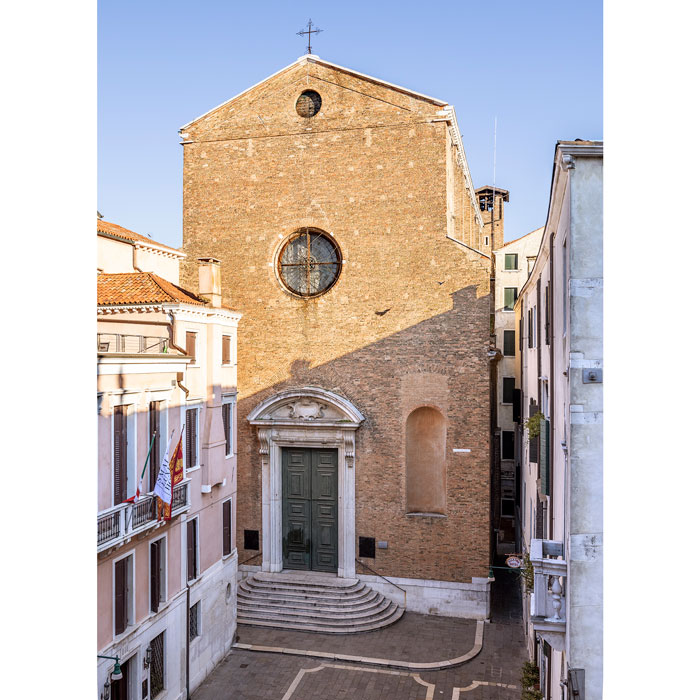
THE PALACE
The palace is located in the heart of the San Marco district, between Piazza San Marco and Rialto Bridge.
The name of the area originates from its famous workshops, which specialize in the handling of tin and pewter. For THDP, it has been crucial to honor the district’s fascinating past. The historical buildings of San Marco each carry a distinct character, with their decorative exteriors having formed the foundation of THDP’s project.
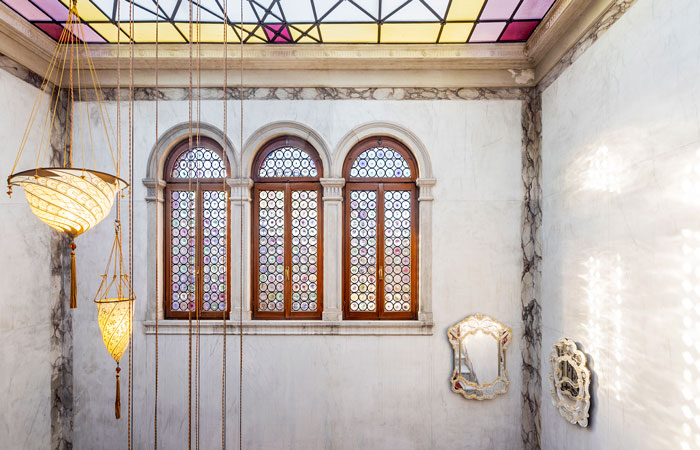
Although more contemporary than other Palace’s overlooking the Grand Canal, the THDP facade still displays striking historical features. The mullioned windows, arches and shutters remain and have been painstakingly preserved by THDP. The typically Venetian cone-shaped fireplaces have been carefully reconstructed to their original state, made possible by the discovery of an old photograph found by the interior designers themselves.
The intricately decorated stucco ceilings overlooking the living rooms, along with the original stairwell, steps and railings have been left untouched, preserving their former integrity.
During renovation, a focus for THDP was refining the staircase. By restoring the original wall appliqués and upgrading the lift doors with elegant marble effect plaster and a surrounding bronze grid, the space has been greatly elevated.
Bringing optimum light into the palazzo has also been of utmost importance. Over the staircase, the skylight has been restored and on the rooftop terrace, the decorated glass of the three-mullioned windows has been repaired. Hung in the centre of the stairwell’s vast skylight is a chandelier, printed in fabric by Fortuny; when illuminated, they leave a mesmerizing effect on the floor below. Despite undergoing repair, the marble-effect marmorino walls and stairs have been left with signs of wear, reflecting the building’s rich past. Protecting the marmorino below, a dark magenta runner is fitted on the staircase, incorporating the colors of Marmorino, and finished with brass rods.
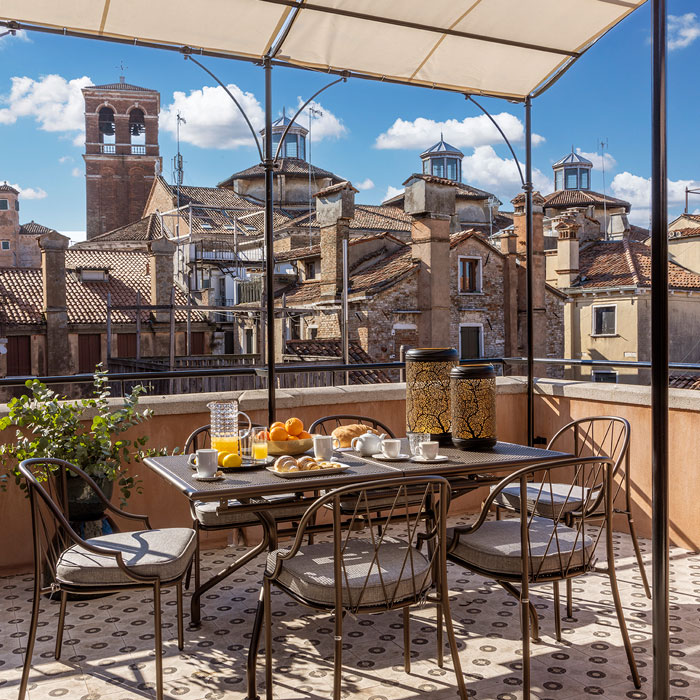
On the ground floor, connecting both entrances into the building, which is accessible by both water and land, is a small lobby. This unique waiting area features outdoor furnishings (as a high tide precaution), and acts as a small shared terrace. This room’s decor is inspired by the turquoise Venetian waters and the colours that decorate the hotel’s exterior. Overall, the style is contemporary with the imperative of keeping the building’s original character.
THE APARTMENTS
Each apartment features an entrance hallway; a living room/kitchen area; two bedrooms (one of which is fitted with an en suite) and two bathrooms. All main rooms enjoy a breathtaking view of one of Venice’s most renowned canals, the Canale De La Fava.
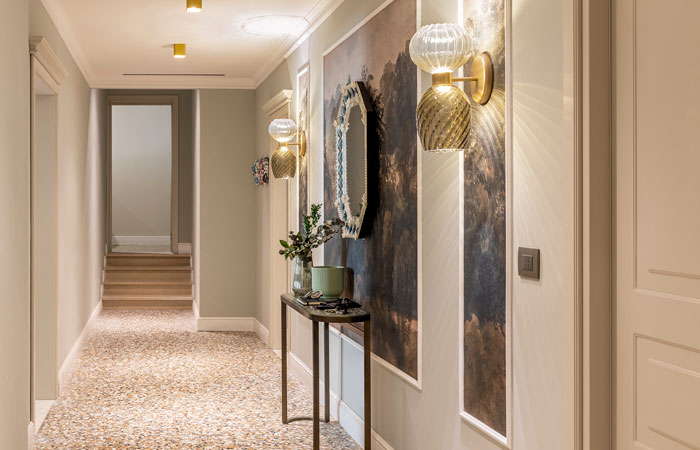
Starting with the living rooms, the style is modern yet ornate, with neutral walls and furnishings that feature mustard, gold, teal, and magenta accents. The purpose of this color scheme is to create a tranquil environment with a lighter palette, whilst also expressing the richness of classic Venetian interiors with some vibrant features.
With a focus on Italian design, much of the decor has been sourced from Veneto or the local area. Notable brands include; Miniforms, Rubelli, Cantori, Vibieffe, Bolzan, Italamp, Siru, Flukso, Besana, Zucchetti, Florim managed by general contractor of the Concreta furnishings and by the Pasqualucci company.
For the bedrooms, the wall colour recalls Venice’s sea water, which is contrasted against the rust created on the metal portals when corroded. For the beds, a quilted, padded headboard with most of them featuring integrated brass tables, will overlook each residential-style Bolzan bed.
In the main bedrooms, the wardrobes will feature glass panes opening into a wallpaper lined closet. The wallpaper features a marbled paper-effect digital print, a Turkish technique brought to Venice by recently deceased Venetian artist Alberto Valese, who founded a small shop in Campo Santo Stefano.
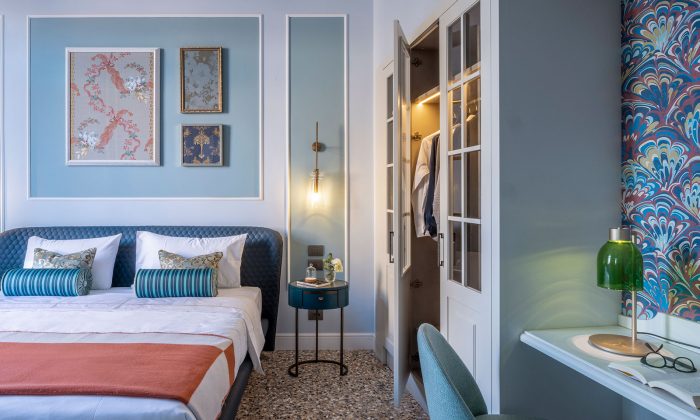
The Kitchens have a more minimalistic design, with dark green handle-less doors designed by Fenix, that feature grooves and a black plinth. The smaller Kitchen appliances have been designed by Smeg; their vintage curved design compliments the more angular structure of the room. As for the accessories, the Baloton-effect glasses and vases are by IVV, and the vintage pewter cutlery and vintage pots are by Mepra.
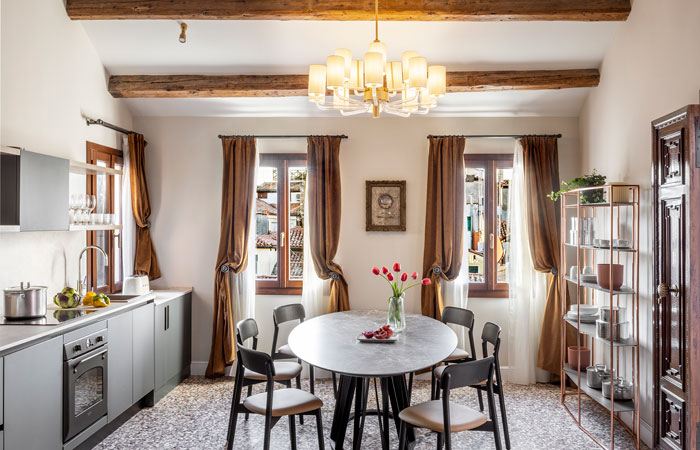
The entrance hallway will feature an elegant wallpaper framed with white molded profiles, produced by Orac Decor. For the more decorative elements, accessories by Les Ottomans and Arcade Murano have been selected, as well as Murano mirrors by Barbini and a console with a dark green crackle effect top by Cantori.
In the bathrooms, the classical Venetian style meets modern materials and sanitation. Here again, the colour palette recalls eighteenth-century wooden furnishings with the use of pastel colours. The wall cladding is by Florim; a stoneware created with high-precision technology that is embossed with a loomed fabric from the Rubelli archive collection. Florim have also designed the floor and wall coverings, made in from porcelain and adorned with a seeded effect.
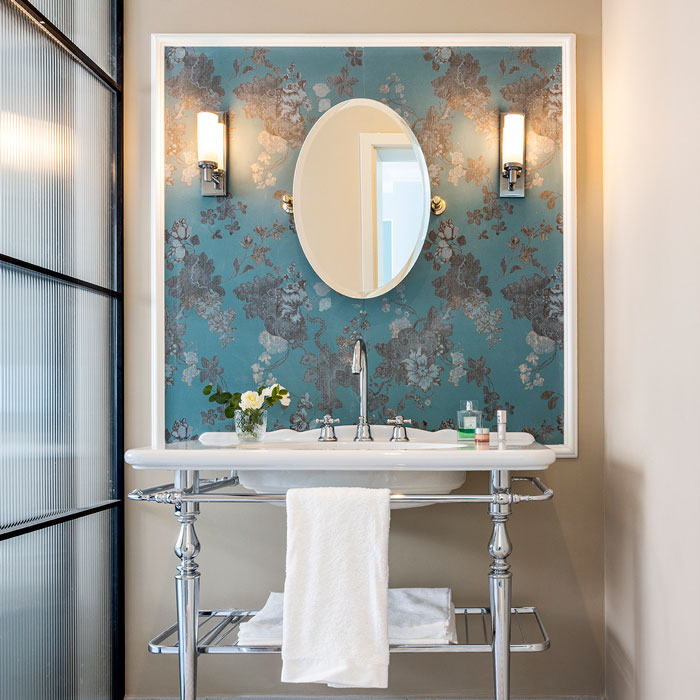
The rooftop suite features a terrace, constructed as an extension of the living area. Overlooking the building’s interior, the balcony offers a breathtaking view over Venice’s rooftops, providing some escape from the bustling streets below.
THE INSPIRATIONS
The crafts of the artisans of Venice
During the 15th century, around 1470, the Calle- where the palace is located, was a hub for artisans. They specifically worked pewter and tin, producing, and repairing crockery, pots and small objects.
This specific craft brought together the producers of tin objects, created mainly for daily use. These products had to be marked with the seal of the guild.
This niche local history is one that inspired certain design elements, specifically those made with a pewter effect. Designed by THDP and created by APIR, the Mepra pewter-finished cutlery and pots, have been created for all 12 apartments and are a nod to the area’s past, each bearing the name of an ancient worker.
The names of the 12 apartments in detail:
- Batioro, the one who marks gold in parchment
- Fustagner, the fustian worker
- Gastaldo, the gondolier leader
- Marangoni, the ship builder
- Mureri, mason, the wood worker
- Passamaner, the bannister maker
- Remer, the oar maker
- Samiter, the silk clothes vendor
- Stagne, the tin worker
- Terazer, the Venetian flooring maker
- Tintor, the cloth dyer
- Tiraoro, the gold silk thread maker
THDP then collected antique pewter cutlery and trays, made by All’Origine, which were then framed and hung on the walls of the living rooms and kitchens.
The Colours of Venice
The colours of Venice represent a passage of time, where pigment has undergone transformation over time. The changing tides wear out, oxidize and stain the surfaces of the city. This has created a spectrum of rich tones that recall nature, the shades of marble and colours historically exclusive to royalty. All of the shades used in the building’s interior and exterior have been derived from this colour palette.
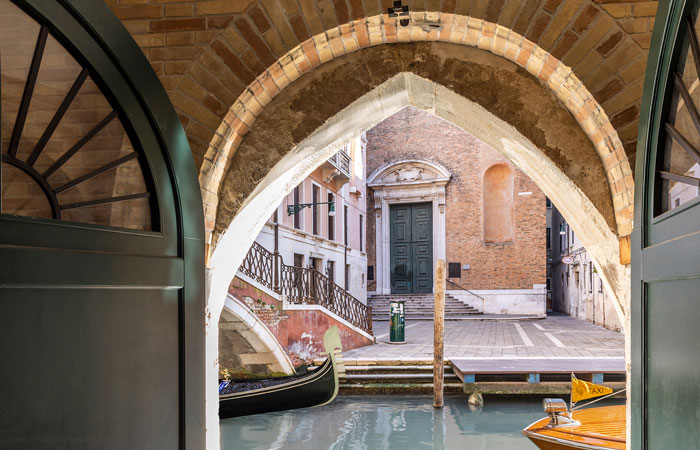
Automatic lighting has been fitted on each window internally, as well as a series of lanterns.
Before the canal entrance, a small dock has been built for mooring.
The Chimneys of Venice
The bell-shaped fireplaces are formed by a truncated cone, with the larger base facing upwards. They represent the classic shape of a Venetian “Camin”, which are often shown in the works of the great painters of the Venetian school and have been defined by experts as one of the most functional fireplaces. In the past, these “bells” have been decorated and frescoed, sometimes by famous artists such as Giorgione and Titian. The unique shape of the fireplaces also allows for an internal smoke cooling, which stops the leakage of incandescent lapilli as a means of fire prevention.
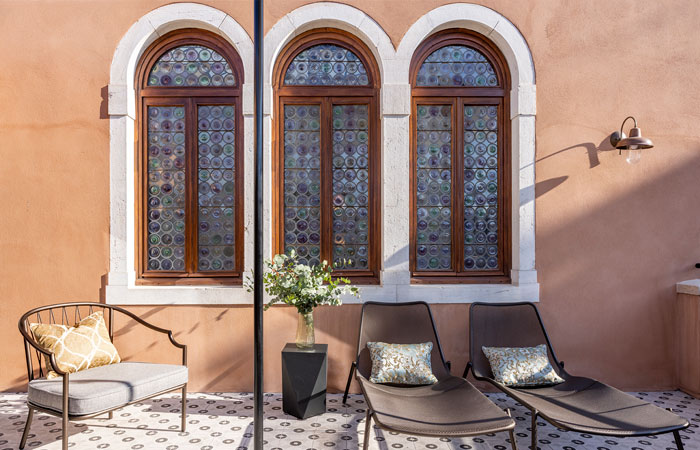
The façade has been coloured with a smooth lime paint, which generates delicate movement due to its light texture. The building’s original appearance has also been recognized, with slender bell-shaped fireplaces being appearing on the façade.
THE ‘MICROLOCAL’ LANGUAGE
With sustainability in mind, the aim of the project was to involve local companies, reflecting the high quality of Italian-made produce and the knowledge of Venetian artisans. The companies selected represent THDP’s vision, perfectly combining classic and contemporary design.
Among the chosen brands is Italamp, a family business with which THDP has designed a collection of lamps using borosilicate and brass. They are inspired by Venetian female figures known as Casanova’s lovers. The colour of the glass, traditional to Venice, have been altered to a bespoke design for the project.
Decorative Murano mirrors by Barbini have been installed on the walls of the apartments and stairwells. These are to honor Murano- one of the major islands in on the Venice Lagoon and renowned for its glass-manufacturing.
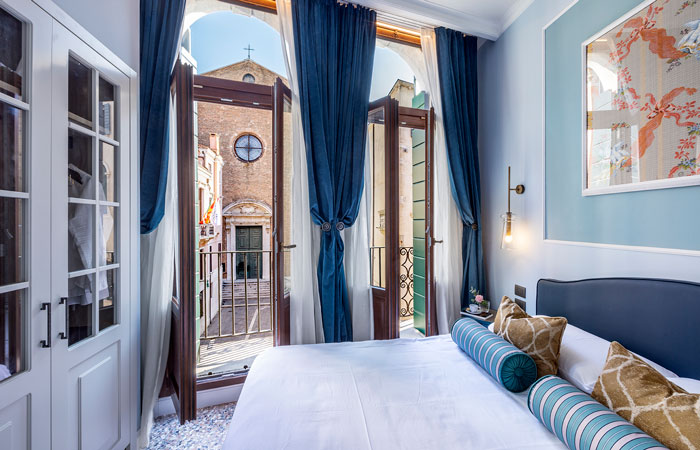
Rubelli was chosen to create the fabrics covering decorative cushions throughout the building, as well as certain upholstered items. Their main project, however was the creation of a a particular artwork in each room, featured behind the headboard. Together with the Agostinelli company, the fabric has been woven on a loom, creating a beautiful design that overlooks the bed. Furthermore, Rubelli fabric has been digitally printed on large Florim tiles, used to frame the bathroom furniture and mirrors.
THE ARTISTIC PROJECT
The 2022 Venice Art Biennale gave the city and THDP an opportunity to admire the union of international artists and local artisans, drawing together classic and modern design.
The choice of decorative accessories inside the apartments aims to celebrate Venetian craft, but with a contemporary twist. Artist Alberto Valese’s marble papers paired with antique frames, and cutlery by All’Origine come together to emulate this intention.
Photography is by Giorgio Baroni.




